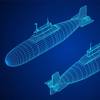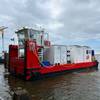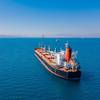A new shape in navy warships is quickly taking shape in the U.K., as Vosper Thornycroft (VT) has completed structural work on the 321 ft. (98 m) Trimaran Warship demonstrator being built for the U.K.'s Defense Evaluation and Research Agency (DERA). The upper bow structure, weighing approximately 25 tons, was maneuvered into position on the RV Triton, which is scheduled for launching this month. The ship will be delivered to DERA in August before starting the initial phase of a trials program that will determine whether trimaran hulls will be considered for the Royal Navy's Future Surface Combatant.
BT has built the ship using mega-blocks weighing up to 200 tons each. Five mega blocks have been fabricated and extensively fitted out before consolidation.
"Building a trimaran of this size has meant dealing with several challenges that we have not encountered in building conventional ships. The lessons learned have been invaluable and have provided us with unrivalled experience in building this from of ship," said VT project manager Mike Carter. "If trimaran is the way ahead, VT is undoubtedly at the forefront.
RV Triton has reached structural completion in less than 15 months since DERA chief executive Sir John Chisholm cut the first steel in January 1999. Accolades for this impressive production schedule is largely attributable to advanced manufacturing methods including the use of a high-quality plasma cutting system.
"The RV Triton build has resulted in new VT productivity records for large steel ships, and this has enabled us to build the ship within the limited budget and to a demanding program," said Carter. "With several new Royal Navy programs on the horizon, the trimaran has been an important demonstration of VT's capabilities."
Alstom, USN Team For Integrated Solution
Alstom Drives & Controls has worked with the U.S. Navy (USN) to produce an electric power and propulsion system which is compact and robust, while meeting exacting and demanding USN standards.
Traditional Navy practice in the realm of ship and equipment development and procurement has largely flown out the window in lieu of investigating and incorporating proven product and system technologies from commercial origins, with a hard-line stance on initial and life-time costs. The benefactors of the "new" attitude is obviously the USN, which has been able to steadily drive down costs while sacrificing little if anything in performance. In addition, it has opened new markets for key component and systems manufacturers once locked out of this lucrative work.
Traditional USN practice has seen the use of mechanical transmission systems, utilizing either nuclear, diesel or gas turbine prime movers. Until recently, electric propulsion was ruled out for many Navy applications because the DC electric motor has various design limits, including power limitations. In planning the new propulsion module for its future ships, however, USN is now considering electric propulsion for specific technical, commercial and operations reasons. Electric systems could potentially help the Navy optimize budgets in some applications.
For example, a typical Navy vessel run at less than 50 percent full power most of the time, a condition ripe for the benefits of an electric system. Electric systems can also be designed for silent operation, critical in today's stealth-stringent environment.
In addition, electric propulsion offers ship designers the flexibility to achieve a compact overall machinery layout, a design which can obviously be more resilient to damage.
Alstom Drives & Controls propose a customized AC induction motor, to fit the tight available space, with the added benefit of a novel PWM converter design to suit either an induction motor or a future permanent magnet motor. The Alstom system is desirable as the company can act as the single-source provider for all power generation and vessel propulsion, helping to ensure smooth integration. All products in the Alstom suite is the result of thorough and effective design to satisfy the elements of shock loading. Generator units are resiliently mounted to withstand 15g above resilient mountings and even the converter suites, with their delicate electronic components, can withstand the shock loading attenuated by resilient mounts. The propulsion motorsare designed to withstand mounting foot shocks up to 80g.
Subscribe for
Maritime Reporter E-News
Maritime Reporter E-News is the maritime industry's largest circulation and most authoritative ENews Service, delivered to your Email five times per week










